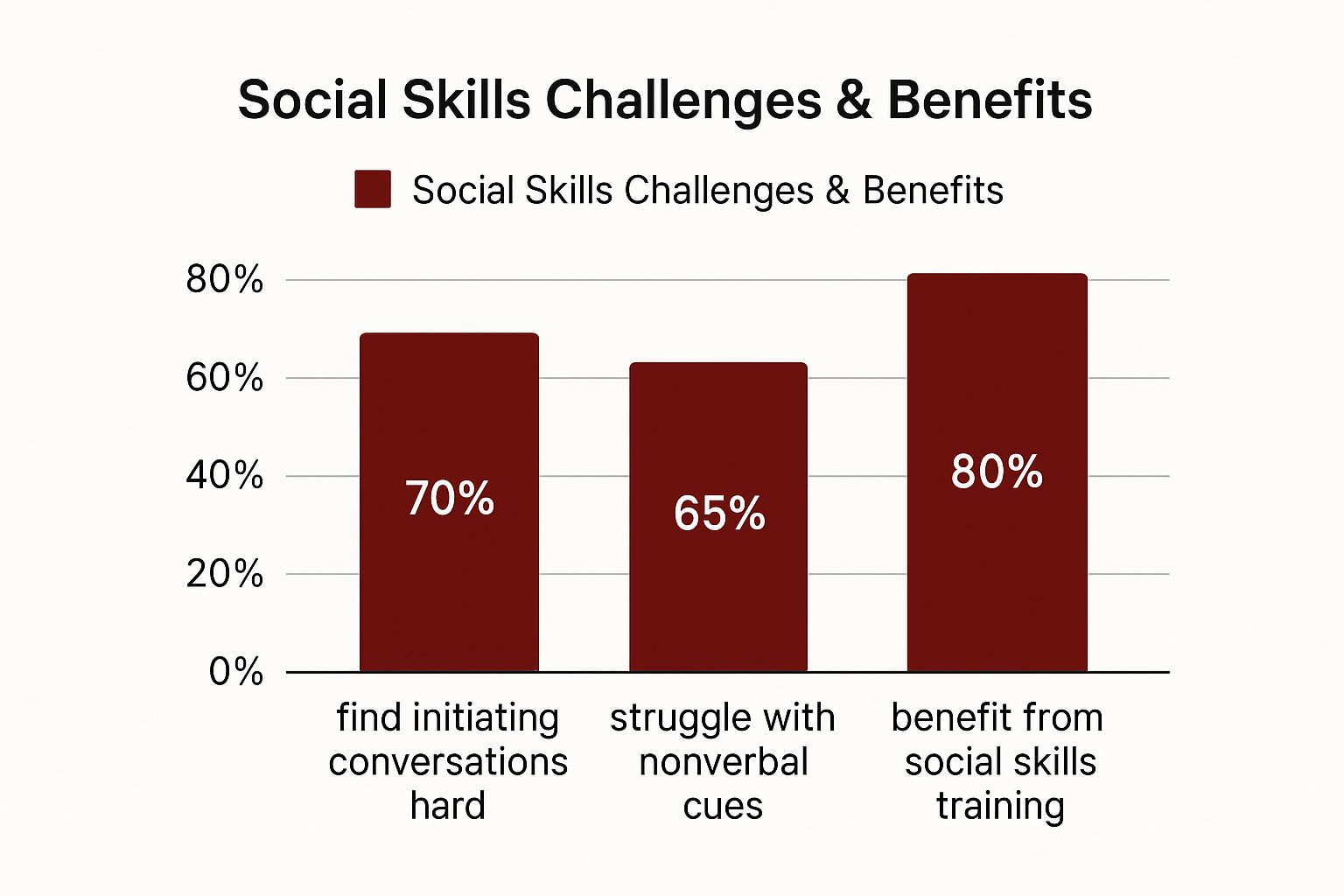Developing social skills as an autistic adult isn't about learning to fake it or changing who you fundamentally are. It’s about building a practical toolkit to navigate social situations with more confidence and a lot less stress. The goal is to understand the unspoken patterns of the social world so you can engage on your own terms.
Your Guide to Navigating the Social World
Does it ever feel like everyone else got a copy of the social rulebook and you didn't? You are far from alone. This guide is designed to move past the dry, clinical advice and offer real, practical strategies rooted in lived experience. It's all about building tools that help you engage with the neurotypical world authentically—without feeling like you have to mask your true self.
The need for this kind of support is more significant than ever. Back in 2000, the autism diagnosis rate in the U.S. was about 1 in 150 children. By 2023, that number had jumped to 1 in 36—an increase of roughly 178%. This isn't just a statistic; it represents a huge and growing community of adults who are looking for resources to help them thrive socially throughout their lives. You can find more details about these important autism prevalence statistics online.
Understanding the Starting Point
Before we jump into specific techniques, it’s really helpful to get a clear picture of the common challenges and the real benefits of working on these skills. This graphic shows where many autistic adults are starting from and the positive changes they can achieve.

The numbers tell a powerful story. While a lot of us find initiating conversations (70%) and figuring out nonverbal cues (65%) to be genuinely difficult, the vast majority (80%) see real value in targeted social skills training.
This isn't about "fixing" something that's broken. It's about empowerment. The whole point is to lower social anxiety and build genuine connections that feel right for you.
A key shift in perspective is recognizing that autistic individuals often have their own organic social skills, such as deep empathy through shared experiences and intense, passionate infodumping. The challenge is often a cultural mismatch, not a social deficit.
A Framework for Skill Development
To make this journey feel less overwhelming, we’re going to break it down into distinct areas of social interaction. Think of these as building blocks. You don't have to master them all at once, but understanding them provides a clear roadmap for what's ahead.
This table gives you a quick overview of the core pillars we’ll be exploring throughout this guide.
| Core Areas of Social Skill Development |
| :— | :— | :— |
| Skill Area | What It Involves | Why It Matters for You |
| Decoding Conversations | Learning to start, maintain, and end chats using practical tools like social scripting and energy management. | Reduces the guesswork in conversations and helps you feel more in control and less drained. |
| Nonverbal Communication | Identifying patterns in body language and tone of voice without getting overwhelmed by trying to read everything. | Helps you better understand context and unspoken messages, preventing common misunderstandings. |
| Building Relationships | Moving beyond small talk to find friends through shared interests and learning the give-and-take of mutual support. | Fosters genuine connections based on who you are, not a performance, leading to more fulfilling friendships. |
| Workplace Navigation | Understanding the unwritten rules of office etiquette, from meetings and small talk to giving and receiving feedback. | Increases your comfort and confidence in professional settings, which is crucial for career well-being. |
| Self-Regulation | Proactively managing social anxiety and sensory overload to prevent burnout and make social events more enjoyable. | Allows you to participate in social life on your own terms, preserving your energy for what matters most. |
Each of these areas builds on the others, creating a solid foundation for more comfortable and authentic social engagement.
- Decoding Conversations: We’ll look at practical tools to start, maintain, and gracefully exit conversations.
- Nonverbal Communication: The focus here is on spotting key patterns in body language and tone without getting bogged down in the details.
- Building Relationships: This is about moving past surface-level interactions to find your people through shared passions and mutual support. For those who want a structured and safe place to practice, a social skills group can be an incredibly supportive environment.
- Workplace Navigation: We’ll demystify the unwritten rules of office life, from meetings to feedback, to make your professional life more comfortable.
- Self-Regulation: Managing social anxiety and sensory input is absolutely vital for preventing burnout and actually enjoying social time.
Decoding Conversations and Nonverbal Cues
Conversations can feel like a high-speed game with rules no one ever gave you. This is especially true when you're trying to read between the lines of what people are really saying. But here's the good news: you don't have to decode every single glance or shift in tone to connect with people.
For autistic adults, building social skills is about finding practical patterns and tools that make these interactions less draining and more genuine. A great place to start is by reframing the idea of "social scripting." It's not about being fake or robotic. Think of it as having a few reliable tools in your back pocket for predictable moments, like greetings or saying goodbye. This saves you a ton of mental energy.
Building Your Social Playbook
The goal is to create your own personalized social playbook—one that feels authentic to you. It’s not about memorizing lines for a performance but about having go-to phrases ready to reduce the mental load when you’re in the moment.
For many of us, just starting a conversation is the hardest part. Instead of freezing up trying to find the "perfect" opener, you can rely on a few simple, context-based questions.
- At a work event: "This is a great turnout. Have you been to one of these before?"
- In a hobby group: "I saw your latest project on the group chat, it looked amazing. How did you get that effect?"
- At a casual party: "I don't think I know many people here. How do you know the host?"
These are all open-ended, meaning they invite the other person to say more than just "yes" or "no." On the flip side, having a planned exit strategy is just as important. It keeps you from getting stuck in conversations that drag on until your social battery is completely empty.
Key Takeaway: A simple phrase like, "Well, it was really nice chatting with you! I'm going to go grab a drink," is a clear, polite, and graceful way to end an interaction. It puts you back in control.
Reading the Room Without Getting Overwhelmed
Trying to interpret nonverbal cues like body language and vocal tone can feel like trying to solve a complex puzzle in real-time. It doesn't help when you hear that over 90% of communication is nonverbal. That statistic alone is enough to cause overwhelm.
The trick is to stop trying to analyze every tiny detail and instead look for broad patterns or "clusters" of signals.
For instance, instead of trying to figure out what a specific facial twitch means, look at the whole picture. Is the person facing you with relaxed, open shoulders? That’s generally a good sign. But if they're angled away, constantly looking around the room, and only giving one-word answers, that whole cluster of cues suggests they're probably distracted or ready to move on.
Here are a few common patterns to look for:
- Open Body Language: Think uncrossed arms, leaning in a bit, and making eye contact (at a level that's comfortable for them). This cluster usually signals engagement and interest.
- Closed Body Language: This often looks like crossed arms, a body turned away, and minimal eye contact. It can mean anything from disinterest and discomfort to simple distraction.
- Vocal Tone: Is their voice higher and faster than usual? That could be excitement or anxiety. A slow, flat tone might signal boredom or fatigue. Listen for shifts from their normal way of speaking.
At the end of the day, remember that communication is a two-way street, and misunderstandings happen to everyone, neurotypical or not. By focusing on bigger patterns and having a few strategies ready, you can make conversations feel more predictable and far less stressful.
Building and Maintaining Meaningful Relationships
Once you get a better handle on conversations, the real work begins: turning those chats into genuine connections. This is where a lot of standard social advice just doesn't cut it for autistic adults. Meaningful relationships aren’t about perfectly following some unwritten social script. They're built on something much deeper—shared understanding, mutual respect, and a real, authentic bond.
So, how do you find your people? The best advice I can give is to lean into your special interests. Forget about forcing yourself into loud, overwhelming bars or parties that just don't feel like you. Instead, look for places where your passions are the main event.
- Hobby-focused groups: Think book clubs, tabletop gaming nights, coding meetups, or local bird-watching societies.
- Online communities: Forums and Discord servers dedicated to your interests can be a fantastic, low-pressure way to connect with like-minded people from the comfort of home.
These kinds of environments are like a natural social filter. You walk in already having something in common, which just melts away a lot of that initial awkwardness and pressure to make small talk.
From Acquaintance to Friend
That jump from friendly acquaintance to actual friend can feel incredibly vague and confusing. It really boils down to showing mutual interest and support, but in small, consistent ways. You don't need big, dramatic gestures; it's the little "bids for connection" that build the foundation.
For instance, if someone you've been talking to mentions a stressful appointment they have coming up, a simple text later asking, "Hope your appointment went okay today," can mean the world. It shows you were listening and that you care, without being intrusive.
This is also where knowing your own limits is so important. For many of us, social difficulties are tangled up with co-occurring conditions like anxiety or ADHD, making social energy even more precious. The way autism impacts communication and emotional give-and-take means that building friendships requires conscious effort and careful energy management. For a deeper look, you can explore how autism and co-occurring conditions affect social life in this resource from the WHO.
Protecting Your Social Battery
Friendships take energy, and for many autistic people, that energy—our "social battery"—is a finite resource. Being mindful of your social battery isn't selfish; it’s absolutely essential for preventing burnout and being able to show up as your best, most authentic self for the people you care about.
A core part of authentic connection is being honest about your needs. Saying, "I've had a really great time, but my social battery is getting low and I need to head home," is a powerful act of self-advocacy. Real friends will get it.
Learning to set these kinds of healthy boundaries is one of the most vital social skills an autistic adult can develop. It allows you to build relationships that can last, without having to mask or push yourself to the breaking point. The goal is to find friendships that energize you more than they deplete you.
Practical Social Skills for the Workplace
The professional world runs on its own set of social rules, and they're often confusing because they're unspoken. For autistic adults, navigating this environment isn't about masking who you are. It’s about building a toolkit of strategies to get through your workday with less stress and more confidence.
This is a critical need. In the United States, an estimated 2.18% of adults are autistic, yet around 75% of them are either underemployed or unemployed. This gap often comes down to challenges with the exact social communication and interaction skills that many workplaces take for granted.
Ultimately, professional success is often tied to how comfortable and effective you feel as part of a team.
Decoding Office Etiquette and Communication
Unspoken office etiquette can feel like trying to cross a minefield. When is it okay to join a casual chat? What does that vague email really mean? The rules can seem completely arbitrary.
A great first step is to simply observe and look for patterns in your own workplace.
- Do people use instant messaging for quick questions, or do they walk over to each other's desks?
- How long do casual chats in the breakroom usually last?
- What’s the general vibe in meetings—formal and structured, or more of a relaxed brainstorm?
Observing these norms gives you a baseline for your specific office culture, taking some of the guesswork out of it.
Written communication can be another source of anxiety. If a manager's email says, "Let's touch base on this project soon," the vagueness can be stressful. It is completely okay to ask for more clarity.
Pro Tip: A simple reply like, "Sounds good. Do you want to find 15 minutes on the calendar tomorrow afternoon to discuss the next steps?" is a proactive and professional way to get the specific information you need without ambiguity.
Contributing to Meetings and Handling Feedback
Meetings can be a major source of stress, especially when you're trying to figure out the right moment to speak. Preparation is your best friend here. Before the meeting, look over the agenda and jot down one or two key points or questions you want to bring up. Having these ready makes it much easier to find a natural opening to contribute.
Receiving feedback is another skill that can be tough to master. It’s hard not to take criticism personally, especially if it isn't delivered well. The key is to try and separate the feedback from your self-worth. Think of it as data you can use to improve, not a judgment on you as a person. This is one of the more challenging workplace interactions, but there are strategies for handling criticism constructively that can help.
Self-Advocacy and Requesting Accommodations
Learning to advocate for yourself is probably the single most important social skill you can develop for the workplace. This means knowing how to clearly and professionally ask for what you need to do your job well.
This isn't a sign of weakness; it's a mark of self-awareness and professionalism. Your needs could be anything from:
- Receiving instructions in writing instead of verbally
- Getting a quieter workspace to minimize distractions
- Using noise-canceling headphones
Many employers are required to provide reasonable accommodations, and asking for them sets both you and your team up for success. For more detailed information, you might find our guide on autism workplace accommodations helpful.
Let’s be real: socializing can be absolutely draining. And when you add social anxiety and sensory overload to the mix, it can feel downright impossible.
For so many autistic adults, these aren't just small hurdles. They’re major barriers that turn social events into a minefield of stress. Building social skills for autistic adults isn't just about learning what to say; it’s about creating a personal toolkit to manage everything happening on the inside.
The link between autism and anxiety is strong, with countless people feeling immense stress in social situations. This anxiety often comes from trying to decode neurotypical social cues, filter out overwhelming sensory input, and constantly worrying about saying or doing the "wrong" thing. You can learn more about the specifics of social anxiety in adults with autism and why this connection is so common.
The goal is to stop reacting to overwhelm in the moment and start planning ahead to protect your own well-being.
How to Prepare: Before, During, and After Social Events
You wouldn't show up to a marathon without a bit of training, right? The same logic applies here. Going into a social event that you know will be draining requires a game plan for your mind and senses.
The Prep Phase: What to Do Before You Go
- Set a hard out. Decide ahead of time exactly how long you'll stay. Telling yourself, "I'm staying for one hour," gives you a clear finish line and makes the whole thing feel much more manageable.
- Know your exit strategy. This isn't just about finding the door. It’s about having a mental map for when you need a break. Scope out a quieter room, a balcony, or an outdoor spot where you can retreat for a few minutes to decompress.
- Pack a sensory kit. This is your personal first-aid kit for your senses. Bring along things that help you self-regulate, like noise-canceling headphones, a subtle fidget toy, or even scented balm you can use to ground yourself when things get too intense.
In the Moment: Your Social Toolkit
- Ground yourself. When you feel that familiar spike of anxiety, pull your focus back to your physical senses. A great technique is the 5-4-3-2-1 method: name five things you see, four things you feel, three you can hear, two you can smell, and one you can taste.
- Take planned breaks. Don’t wait until you're running on empty. It is perfectly okay to step away for five minutes every half hour to reset. This isn't being rude; it’s essential self-care.
Remember, leaving early or taking breaks isn't a social failure—it's a social success. It means you listened to your body and successfully managed your own well-being. That is a skill in itself.
The Aftermath: Recognizing Burnout and Prioritizing Recovery
Socializing uses energy. For autistic folks, that energy drain is often much, much higher, which can lead to what's known as autistic burnout. This isn't just feeling a bit tired; it's a profound state of exhaustion that can bleed into every part of your life.
Scheduling dedicated downtime after socializing isn’t a luxury—it’s non-negotiable. This is how you recharge your battery and keep burnout at bay.
Your recovery might look like deep-diving into a special interest, enjoying some parallel play with a trusted friend, or simply basking in quiet solitude. By respecting your limits and building in recovery time, you can create a social life that’s actually sustainable and, over time, genuinely more enjoyable.
Common Questions About Adult Social Skills
When you're an autistic adult trying to make sense of the social world, it’s only natural to have a lot of questions. Let's tackle some of the most common ones with straightforward advice you can actually use.
Is It Possible to Learn Social Skills as an Adult?
Yes, absolutely. It is never too late. Your brain is always learning and adapting—a process called neuroplasticity—and this doesn't just stop when you become an adult. Learning social skills for autistic adults isn't about becoming someone you're not. It's about adding new tools to your toolbox and getting better at spotting social patterns.
Think of it like picking up a new language or learning to play the guitar. It takes focused effort, a willingness to practice in low-pressure situations, and finding strategies that click for you. Over time, you can build real, lasting confidence and feel more at ease in social settings, no matter your age.
What Should I Do if I Make a Social Mistake?
First, remember that everyone makes social blunders. Neurotypical people do it all the time. The goal isn't to be perfect—that's impossible. The real skill is learning how to recover gracefully. Honestly, getting stuck in a loop of over-analyzing a small misstep causes far more pain than the mistake itself.
Most people are not hanging on your every word. A quick, simple apology like, "Sorry, I don't think that came out right," is usually all you need. The most important skill here is learning to give yourself some grace and move on.
Focus on the recovery, not the mistake. A quick course correction shows you’re self-aware, and people often appreciate that more than if you just pretend the awkward moment didn't happen. Building social resiliency is a game-changer.
How Can I Find Other Autistic Adults to Connect With?
Finding your community can be one of the most powerful and validating things you do. When you connect with other neurodivergent people, social interactions often feel less draining because there's a built-in understanding. You don't have to constantly explain or translate your own experience.
Here are a few practical ways to find your people:
- Online Forums and Groups: Websites and social media are filled with groups for autistic adults. These can be incredible places for peer support, shared experiences, and genuine friendships.
- Special Interest Clubs: Lean into the things you're passionate about. Whether it’s a coding club, a board game café, a book group, or a local bird-watching society, shared interests are a natural bridge to connection.
- Neurodiversity-Affirming Support Groups: Search for local or online groups created specifically for autistic adults. These are designed to be safe, non-judgmental spaces where you can feel comfortable and even practice social skills.
Connecting with people who just get it can make a world of difference in reducing feelings of isolation. It's a powerful reminder that there's nothing wrong with how you're wired—you just needed to find the right audience.
At Sachs Center, we understand that getting clarity is the first step. Our specialized online evaluations for Autism and ADHD are designed to provide you with the answers and resources you need to move forward confidently. If you're ready to understand your unique neurotype, book your diagnostic evaluation with us today.


